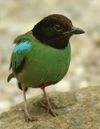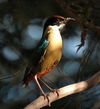Genus Pitta
African Pitta - The African Pitta, Pitta angolensis, is a species of bird in the Pittidae family. It is found in Angola, Burundi, Cameroon, Central African Republic, Republic of the Congo, Democratic Republic of the Congo, Ivory Coast, Equatorial Guinea, Ethiopia, Gabon, Ghana, Kenya, Liberia, Malawi, Mozambique, Nigeria, Rwanda, Sierra Leone, South Africa, Tanzania, Togo, Uganda, Zambia, and Zimbabwe.
Indian Pitta - The Indian Pitta, Pitta brachyura, is a medium-sized passerine bird. It breeds mainly in the sub-Himalayas and winters in southern India and Sri Lanka. These birds are found in thick undergrowth and are often more easily detected by their calls. They however often crash into houses during the migratory season and their brilliant colouration makes them an object of curiosity and are often covered in newspaper stories.
Pitta dohertyi - Its natural habitat is subtropical or tropical moist lowland forests. It is threatened by habitat loss.
Elegant Pitta - Its natural habitats are subtropical or tropical dry forests and subtropical or tropical moist lowland forests.
Banded Pitta - It includes four subspecies, which can be divided into three main groups: The nominate subspecies from Java and Bali has a yellow eyebrow, underparts that are densely barred in yellowish and blackish-blue and a narrow blue band on the upper chest, irena and ripleyi from the Thai-Malay Peninsula and Sumatra have a more orange eyebrow, a blue belly and a chest that is barred orange and dark bluish , and schwaneri from Borneo has a blue mid-belly and yellow flanks and chest densely barred with blackish. Females of all subspecies are significantly duller than the males. There are also vocal differences between some of the subspecies.
Gurney's Pitta - This beautiful bird has a blue crown and black-and-yellow underparts. The rest of the head is black, and it has warm brown upperparts. The female has a brown crown and buffy-whitish underparts. The name of this bird commemorates the English ornithologist John Henry Gurney. It eats slugs and worms.
Rainbow Pitta - An Australian endemic, the Rainbow Pitta lives in the forests of northern Australia. As with other pittas, it is a secretive and shy bird. The diet consists mainly of insects, arthropods and small animals. The female lays three to four glossy cream eggs with blotches inside its large domed nest.
Whiskered Pitta - Its natural habitat is subtropical or tropical moist montanes. It is threatened by habitat loss.
Ivory-breasted Pitta - Its natural habitat is subtropical or tropical moist lowland forests.
Mangrove Pitta - Its natural habitat is subtropical or tropical mangrove forests. It is threatened by habitat loss.
Blue-winged Pitta - Wings spread to get warmed by the sun
Blue-naped Pitta - It is found in Bangladesh, Bhutan, China, Laos, Myanmar, Nepal, Republic of India and Vietnam. Its natural habitats are subtropical or tropical moist lowland forests and subtropical or tropical moist montane forests.
Green-breasted Pitta - Its natural habitat is subtropical or tropical moist lowland forests.
Schneider's Pitta - Its natural habitat is subtropical or tropical moist montanes. It is threatened by habitat loss. The Schneider's Pitta, Pitta schneideri, is a species of bird in the Pittidae family. It is endemic to Indonesia. Its natural habitat is subtropical or tropical moist montanes. It is threatened by habitat loss. It was only rediscovered in 1988 after last been seen in 1918.
Hooded Pitta - Hooded Pittas can reach a length of 16 to 19 cm and a weight of 42 to 70 g. Their diet consists of various insects , which they hunt on the ground, and berries. In the breeding period, which lasts from February to August, they build nests on the ground; both parent take care of the eggs and the fledglings. They are highly territorial and their fluty double-noted whistle calls can be constantly heard from their territories, sometimes throughout the nights.
Blue-rumped Pitta - Its natural habitats are subtropical or tropical moist lowland forests and subtropical or tropical moist montanes.
Azure-breasted Pitta - Its natural habitat is subtropical or tropical moist lowland forests. It is threatened by habitat loss.
Superb Pitta - The Superb Pitta is distributed and endemic to primary and secondary forests of the Manus Island of Papua New Guinea. As with other pittas, it is a secretive and rarely seen terrestrial bird. The diet consists mainly of snails.
Graceful pitta - Its natural habitat is subtropical or tropical moist montanes. It is threatened by habitat loss.
Noisy Pitta - The Noisy Pitta has a bright orange belly and a black face with a brown head on top






